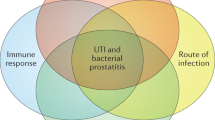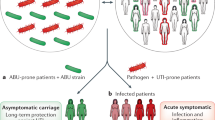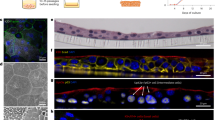Abstract
Urinary tract infections (UTIs) typically evoke prompt and vigorous innate bladder immune responses, including extensive exfoliation of the epithelium. To explain the basis for the extraordinarily high recurrence rates of UTIs, we examined adaptive immune responses in mouse bladders. We found that, following each bladder infection, a highly T helper type 2 (TH2)–skewed immune response directed at bladder re-epithelialization is observed, with limited capacity to clear infection. This response is initiated by a distinct subset of CD301b+OX40L+ dendritic cells, which migrate into the bladder epithelium after infection before trafficking to lymph nodes to preferentially activate TH2 cells. The bladder epithelial repair response is cumulative and aberrant as, after multiple infections, the epithelium was markedly thickened and bladder capacity was reduced relative to controls. Thus, recurrence of UTIs and associated bladder dysfunction are the outcome of the preferential focus of the adaptive immune response on epithelial repair at the expense of bacterial clearance.
This is a preview of subscription content, access via your institution
Access options
Access Nature and 54 other Nature Portfolio journals
Get Nature+, our best-value online-access subscription
$29.99 / 30 days
cancel any time
Subscribe to this journal
Receive 12 print issues and online access
$209.00 per year
only $17.42 per issue
Buy this article
- Purchase on Springer Link
- Instant access to full article PDF
Prices may be subject to local taxes which are calculated during checkout







Similar content being viewed by others
Data availability
All data supporting the findings of this study are available within the article and its supplementary information and from the corresponding author upon reasonable request.
References
Foxman, B., Barlow, R., D’Arcy, H., Gillespie, B. & Sobel, J. D. Urinary tract infection: self-reported incidence and associated costs. Ann. Epidemiol. 10, 509–515 (2000).
Silverman, J. A., Schreiber, H. L. IV., Hooton, T. M. & Hultgren, S. J. From physiology to pharmacy: developments in the pathogenesis and treatment of recurrent urinary tract infections. Curr. Urol. Rep. 14, 448–456 (2013).
Foxman, B. Urinary tract infection syndromes: occurrence, recurrence, bacteriology, risk factors, and disease burden. Infect. Dis. Clin. North Am. 28, 1–3 (2014).
Al-Badr, A. & Al-Shaikh, G. Recurrent urinary tract infections management in women: a review. Sultan Qaboos Univ. Med. J. 13, 359–367 (2013).
Flores-Mireles, A. L., Walker, J. N., Caparon, M. & Hultgren, S. J. Urinary tract infections: epidemiology, mechanisms of infection and treatment options. Nat. Rev. Microbiol. 13, 269–284 (2015).
Chan, C. Y., John, A. L. & Abraham, S. N. Mast cell interleukin-10 drives localized tolerance in chronic bladder infection. Immunity 38, 349–359 (2013).
Hooton, T. M. Recurrent urinary tract infection in women. Int. J. Antimicrob. Agents 17, 259–268. (2001).
Foxman, B. Recurring urinary tract infection: incidence and risk factors. Am. J. Public Health 80, 331–333 (1990).
Ikähelmo, R. et al. Recurrence of urinary tract infection in a primary care setting: analysis of a 1-year follow-up of 179 women. Clin. Infect. Dis. 22, 91–99 (1996).
Kaye, M. G., Fox, M. J., Bartlett, J. G., Braman, S. S. & Glassroth, J. The clinical spectrum of Staphylococcus aureus pulmonary infection. Chest 97, 788–792 (1990).
Mogulkoc, N. et al. Acute purulent exacerbation of chronic obstructive pulmonary disease and Chlamydia pneumoniae infection. Am. J. Respir. Crit. Care Med. 160, 349–353 (1999).
Caminero, J. A. et al. Exogenous reinfection with tuberculosis on a European island with a moderate incidence of disease. Am. J. Respir. Crit. Care Med. 163, 717–720 (2001).
Zar, F. A., Bakkanagari, S. R., Moorthi, K. M. & Davis, M. B. A comparison of vancomycin and metronidazole for the treatment of Clostridium difficile-associated diarrhea, stratified by disease severity. Clin. Infect. Dis. 45, 302–307 (2007).
Borody, T. J. et al. Recurrence of duodenal ulcer and Campylobacter pylori infection after eradication. Med. J. Aust. 151, 431–435 (1989).
Niv, Y. & Hazazi, R. Helicobacter pylori recurrence in developed and developing countries: meta-analysis of 13C-urea breath test follow-up after eradication. Helicobacter 13, 56–61 (2008).
Abraham, S. N. & Miao, Y. The nature of immune responses to urinary tract infections. Nat. Rev. Immunol. 15, 655–663 (2015).
Wu, J., Miao, Y. & Abraham, S. N. The multiple antibacterial activities of the bladder epithelium. Ann. Tranl Med. 5, 35 (2017).
Haraoka, M. et al. Neutrophil recruitment and resistance to urinary tract infection. J. Infect. Dis. 180, 1220–1229 (1999).
Schiwon, M. et al. Crosstalk between sentinel and helper macrophages permits neutrophil migration into infected uroepithelium. Cell 156, 456–468 (2014).
Tittel, A. P. et al. Kidney dendritic cells induce innate immunity against bacterial pyelonephritis. J. Am. Soc. Nephrol. 22, 1435–1441 (2011).
Mulvey, M. A., Schilling, J. D. & Hultgren, S. J. Establishment of a persistent Escherichia coli reservoir during the acute phase of a bladder infection. Infect. Immun. 69, 4572–4579 (2001).
Choi, H. W. et al. Loss of bladder epithelium induced by cytolytic mast cell granules. Immunity 45, 1258–1269 (2016).
Percival, A., Brumfitt, W. & De Louvois, J. Serum-antibody levels as an indication of clinically inapparent pyelonephritis. Lancet 284, 1027–1033 (1964).
Sanford, B. A., Thomas, V. L., Forland, M. A., Carson, S. A. & Shelokov, A. L. Immune response in urinary tract infection determined by radioimmunoassay and immunofluorescence: serum antibody levels against infecting bacterium and Enterobacteriaceae common antigen. J. Clin. Microbiol. 8, 575–579 (1978).
Clark, H., Ronald, A. R. & Turck, M. Serum antibody response in renal versus bladder bacteriuria. J. Infect. Dis. 123, 539–543 (1971).
Ramakrishnan, K. & Scheid, D. C. Diagnosis and management of acute pyelonephritis in adults. Am. Fam. Physician 71, 933–942 (2005).
Jones-Carson, J., Balish, E. & Uehling, D. T. Susceptibility of immunodeficient gene-knockout mice to urinary tract infection. J. Urol. 161, 338–341 (1999).
Thumbikat, P., Waltenbaugh, C., Schaeffer, A. J. & Klumpp, D. J. Antigen-specific responses accelerate bacterial clearance in the bladder. J. Immunol. 176, 3080–3086 (2006).
Mora-Bau, G. et al. Macrophages subvert adaptive immunity to urinary tract infection. PLoS Pathog. 11, e1005044 (2015).
Sivick, K. E., Schaller, M. A., Smith, S. N. & Mobley, H. L. The innate immune response to uropathogenic Escherichia coli involves IL-17A in a murine model of urinary tract infection. J. Immunol. 184, 2065–2075 (2010).
Curtsinger, J. M. & Mescher, M. F. Inflammatory cytokines as a third signal for T cell activation. Curr. Opin. Immunol. 22, 333–340 (2010).
Flynn, S., Toellner, K. M., Raykundalia, C., Goodall, M. & Lane, P. CD4 T cell cytokine differentiation: the B cell activation molecule, OX40 ligand, instructs CD4 T cells to express interleukin 4 and upregulates expression of the chemokine receptor, Blr-1. J. Exp. Med. 188, 297–304 (1998).
Macatonia, S. E. et al. Dendritic cells produce IL-12 and direct the development of Th1 cells from naive CD4+ T cells. J. Immunol. 154, 5071–5079 (1995).
Croft, M., Bradley, L. M. & Swain, S. L. Naive versus memory CD4 T cell response to antigen. Memory cells are less dependent on accessory cell costimulation and can respond to many antigen-presenting cell types including resting B cells. J. Immunol. 152, 2675–2685 (1994).
Croft, M. & Swain, S. L. Recently activated naive CD4 T cells can help resting B cells, and can produce sufficient autocrine IL-4 to drive differentiation to secretion of T helper 2-type cytokines. J. Immunol. 154, 4269–4282 (1995).
Julia, V. et al. Priming by microbial antigens from the intestinal flora determines the ability of CD4+ T cells to rapidly secrete IL-4 in BALB/c mice infected with Leishmania major. J. Immunol. 165, 5637–5645 (2000).
Hegazy, A. N. et al. Circulating and tissue-resident CD4+ T cells with reactivity to intestinal microbiota are abundant in healthy individuals and function is altered during inflammation. Gastroenterology 153, 1320–1337 (2017).
Farber, D. L., Yudanin, N. A. & Restifo, N. P. Human memory T cells: generation, compartmentalization and homeostasis. Nat. Rev. Immunol. 14, 24–35 (2014).
Honda, K. & Littman, D. R. The microbiota in adaptive immune homeostasis and disease. Nature 535, 75–84 (2016).
Williams, W. B., Han, Q. & Haynes, B. F. Cross-reactivity of HIV vaccine responses and the microbiome. Curr. Opin. HIV AIDS 13, 9–14 (2018).
Su, L. F., Kidd, B. A., Han, A., Kotzin, J. J. & Davis, M. M. Virus-specific CD4+ memory-phenotype T cells are abundant in unexposed adults. Immunity 38, 373–383 (2013).
Sawicka, E. et al. Inhibition of Th1-and Th2-mediated airway inflammation by the sphingosine 1-phosphate receptor agonist FTY720. J. Immunol. 171, 6206–6214 (2003).
Reinhardt, R. L., Liang, H. E. & Locksley, R. M. Cytokine-secreting follicular T cells shape the antibody repertoire. Nat. Immunol. 10, 385–393 (2009).
Reinhardt, R. L. et al. A novel model for IFN-γ–mediated autoinflammatory syndromes. J. Immunol. 194, 2358–2368. (2015).
Mohrs, M., Shinkai, K., Mohrs, K. & Locksley, R. M. Analysis of type 2 immunity in vivo with a bicistronic IL-4 reporter. Immunity 15, 303–311 (2001).
Hopkins, W. J., Gendron-Fitzpatrick, A., Balish, E. & Uehling, D. T. Time course and host responses to Escherichia coli urinary tract infection in genetically distinct mouse strains. Infect. Immun. 66, 2798–2802. (1998).
Wynn, T. A. Type 2 cytokines: mechanisms and therapeutic strategies. Nat. Rev. Immunol. 15, 271–282 (2015).
Walker, J. A. & McKenzie, A. N. TH2 cell development and function. Nat. Rev. Immunol. 18, 121–133 (2018).
Murray, P. J. & Wynn, T. A. Protective and pathogenic functions of macrophage subsets. Nat. Rev. Immunol. 11, 723–737 (2011).
Chen, F. et al. An essential role for TH2-type responses in limiting acute tissue damage during experimental helminth infection. Nat. Med. 18, 260–266 (2012).
Raes, G. et al. Differential expression of FIZZ1 and Ym1 in alternatively versus classically activated macrophages. J. Leukoc. Biol. 71, 597–602 (2002).
Gordon, S. & Martinez, F. O. Alternative activation of macrophages: mechanism and functions. Immunity 32, 593–604 (2010).
Conway, J. G. et al. Inhibition of colony-stimulating-factor-1 signaling in vivo with the orally bioavailable cFMS kinase inhibitor GW2580. Proc. Natl Acad. Sci. USA 102, 16078–16083 (2005).
He, H. et al. Endothelial cells provide an instructive niche for the differentiation and functional polarization of M2-like macrophages. Blood 120, 3152–3162 (2012).
Klinkert, K. et al. Selective M2 macrophage depletion leads to prolonged inflammation in surgical wounds. Eur. Surgical Res. 58, 109–120 (2017).
Kumamoto, Y. et al. CD301b+ dermal dendritic cells drive T helper 2 cell-mediated immunity. Immunity 39, 733–743 (2013).
Kumamoto, Y., Denda-Nagai, K., Aida, S., Higashi, N. & Irimura, T. MGL2+ dermal dendritic cells are sufficient to initiate contact hypersensitivity in vivo. PloS One 4, e5619 (2009).
Gao, Y. et al. Control of T helper 2 responses by transcription factor IRF4-dependent dendritic cells. Immunity 39, 722–732 (2013).
Connor, L. M., Tang, S. C., Camberis, M., Le Gros, G. & Ronchese, F. Helminth-conditioned dendritic cells prime CD4+ T cells to IL-4 production in vivo. J. Immunol. 193, 2709–2717 (2014).
Sokol, C. L., Camire, R. B., Jones, M. C. & Luster, A. D. The chemokine receptor CCR8 promotes the migration of dendritic cells into the lymph node parenchyma to initiate the allergic immune response. Immunity 49, 449–463 (2018).
Amsen, D. et al. Instruction of distinct CD4 T helper cell fates by different Notch ligands on antigen-presenting cells. Cell 117, 515–526 (2004).
Zhu, J., Yamane, H. & Paul, W. E. Differentiation of effector CD4 T cell populations. Annu. Rev. Immunol. 28, 445–489 (2009).
Zhu, J. & Paul, W. E. CD4 T cells: fates, functions, and faults. Blood 112, 1557–1569 (2008).
Fields, P. E., Kim, S. T. & Flavell, R. A. Cutting edge: changes in histone acetylation at the IL-4 and IFN-γ loci accompany Th1/Th2 differentiation. J. Immunol. 169, 647–650 (2002).
Bashyam, H. Th1/Th2 cross-regulation and the discovery of IL-10. J. Exp. Med. 204, 237 (2007).
Brubaker, L. & Wolfe, A. The urinary microbiota: a paradigm shift for bladder disorders? Curr. Opin. Obstet. Gynecol. 28, 407–412 (2016).
Antunes-Lopes, T. et al. The role of urinary microbiota in lower urinary tract dysfunction: a systematic review. Eur. Urol. Focus 6, 361–369 (2020).
Yeung, C. K., Sreedhar, B., Leung, Y. F. & Sit, K. Y. Correlation between ultrasonographic bladder measurements and urodynamic findings in children with recurrent urinary tract infection. BJU Int. 99, 651–655 (2007).
Shaikh, N. Recurrent urinary tract infections in children with bladder and bowel dysfunction. Pediatrics 137, e20152982 (2016).
Cho, M. et al. Fibrinogen cleavage products and Toll-like receptor 4 promote the generation of programmed cell death 1 ligand 2–positive dendritic cells in allergic asthma. J. Allergy Clin. Immunol. 142, 530–541 (2018).
Arifuzzaman, M. et al. MRGPR-mediated activation of local mast cells clears cutaneous bacterial infection and protects against reinfection. Sci. Adv. 5, eaav0216 (2019).
O’Brien, V. P. et al. A mucosal imprint left by prior Escherichia coli bladder infection sensitizes to recurrent disease. Nat. Microbiol. 2, 16196 (2017).
O’Brien, V. P., Dorsey, D. A., Hannan, T. J. & Hultgren, S. J. Host restriction of Escherichia coli recurrent urinary tract infection occurs in a bacterial strain-specific manner. PLoS Pathog. 14, e1007457 (2018).
Normark, S. et al. Genetics of digalactoside-binding adhesin from a uropathogenic Escherichia coli strain. Infect. Immun. 41, 942–949 (1983).
Di Pilato, M. et al. Targeting the CBM complex causes Treg cells to prime tumours for immune checkpoint therapy. Nature 570, 112–116 (2019).
Geesala, R. et al. Loss of RHBDF2 results in an early-onset spontaneous murine colitis. J. Leukoc. Biol. 105, 767–781 (2019).
Levin, R. M. et al. Trypan blue as an indicator of urothelial integrity. Neurourol. Urodyn. 9, 269–279 (1990).
Warburton, D. et al. Epigenetic role of epidermal growth factor expression and signalling in embryonic mouse lung morphogenesis. Dev. Biol. 149, 123–133 (1992).
Troyer, K. L. et al. Growth retardation, duodenal lesions, and aberrant ileum architecture in triple null mice lacking EGF, amphiregulin, and TGF-α. Gastroenterology 121, 68–78 (2001).
Marjou, A. E., Delouvée, A., Thiery, J. P. & Radvanyi, F. Involvement of epidermal growth factor receptor in chemically induced mouse bladder tumour progression. Carcinogenesis 2, 2211–2218 (2000).
Powell-Braxton, L. et al. IGF-I is required for normal embryonic growth in mice. Genes Dev. 7, 2609–2617 (1993).
Leighton, P. A., Ingram, R. S., Eggenschwiler, J., Efstratiadis, A. & Tilghman, S. M. Disruption of imprinting caused by deletion of the H19 gene region in mice. Nature 375, 34–39 (1995).
Lumeng, C. N., Bodzin, J. L. & Saltiel, A. R. Obesity induces a phenotypic switch in adipose tissue macrophage polarization. J. Clin. Invest. 117, 175–184 (2007).
Inouye, B. M. et al. Diabetic bladder dysfunction is associated with bladder inflammation triggered through hyperglycemia, not polyuria. Res. Rep. Urol. 10, 219–225 (2018).
Hughes, F. M. et al. NLRP3 promotes diabetic bladder dysfunction and changes in symptom-specific bladder innervation. Diabetes 68, 430–440 (2019).
Acknowledgements
We thank R. Locksley for providing the reporter strains. We thank the Duke Light Microscopy Core Facility, especially Y. Gao, for their expertise and advice in light microscopy imaging. We thank the Flow Cytometry Shared Resource of the Duke Cancer Institute for their assistance with flow cytometry analysis. We also appreciate the help of M.-N. Huang in the design of the flow cytometry panel. The authors acknowledge the support of the US National Institutes of Health grants R01DK121032 and R01DK121969 to S.N.A.
Author information
Authors and Affiliations
Contributions
Studies were designed by J.W. and S.N.A. with help from R.L.R., J.T.P., F.M.H. and Y.M. Experiments were performed by J.W., B.W.H., C.P., G.S.M. and H.W.C. Data were analyzed by J.W. and S.N.A. The manuscript was written by J.W. and S.N.A. All authors contributed to discussions and manuscript review.
Corresponding author
Ethics declarations
Competing interests
The authors declare no competing interests.
Additional information
Peer review information Ioana Visan was the primary editor on this article and managed its editorial process and peer review in collaboration with the rest of the editorial team.
Publisher’s note Springer Nature remains neutral with regard to jurisdictional claims in published maps and institutional affiliations.
Supplementary information
Supplementary Information
Supplementary Figures 1–7.
Source data
Source Data Fig. 1
Statistical Source Data.
Source Data Fig. 2
Statistical Source Data.
Source Data Fig. 3
Statistical Source Data.
Source Data Fig. 4
Statistical Source Data.
Source Data Fig. 5
Statistical Source Data.
Source Data Fig. 6
Statistical Source Data.
Source Data Fig. 7
Statistical Source Data.
Rights and permissions
About this article
Cite this article
Wu, J., Hayes, B.W., Phoenix, C. et al. A highly polarized TH2 bladder response to infection promotes epithelial repair at the expense of preventing new infections. Nat Immunol 21, 671–683 (2020). https://doi.org/10.1038/s41590-020-0688-3
Received:
Accepted:
Published:
Issue Date:
DOI: https://doi.org/10.1038/s41590-020-0688-3
This article is cited by
-
Targeting metabolic sensing switch GPR84 on macrophages for cancer immunotherapy
Cancer Immunology, Immunotherapy (2024)
-
From mucosal infection to successful cancer immunotherapy
Nature Reviews Urology (2023)
-
Gut OncoMicrobiome Signatures (GOMS) as next-generation biomarkers for cancer immunotherapy
Nature Reviews Clinical Oncology (2023)
-
Sex differences in the aging murine urinary bladder and influence on the tumor immune microenvironment of a carcinogen-induced model of bladder cancer
Biology of Sex Differences (2022)
-
Substantial overlap between symptomatic and asymptomatic genitourinary microbiota states
Microbiome (2022)



